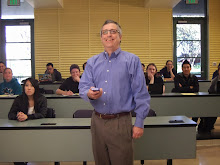At a high level, I definitely agree that being an entrepreneur and being in school don't necessarily mix. Most of us know of Exhibits 1 (Bill Gates) and 2 (Mark Zuckerberg) from Harvard, but I have met dozens of other successful entrepreneurs who felt a greater need to get going on an opportunity than to wait around to complete a degree.
However, for most of the rest of us, the analytical skills honed in college or grad school, along with the opportunity to network and explore different fields prove invaluable later. With that in mind, I created a new course at San Jose State last year, the Entrepreneurship Lab (E-Lab). The seminar course combined an internship at a start-up or venture firm with classroom learning and sharing of experiences. There was an application and interview process to be admitted to the class so I was able to have a diverse group of students with varied educational and work backgrounds. Business, Engineering, Computer Science, and Design were all represented.
I'm teaching the class again this coming semester and held an information session for prospective students this week. I had several of the students from E-Lab I come to share their experience with those interested in applying for E-Lab II (went with the Super Bowl numbering scheme to see if I can convince the powers that be to make this a permanent part of the curriculum). I was blown away by some of the testimonials of how the course was a career and life altering experience for the students. I realized that opportunities like this are so rare and students don't get enough of this type of experiential education.
Here are a couple of quotes from the students:
"The internship provoked by thinking and challenged me to pursue my interests with more drive and determination. The opportunity provided by the [E-Lab] has been truly inspiring. And now I know exactly where I want to spend my time"I think something else they liked was that there was no final exam, since in the real world, you are judged by the market and investors rather than on a grading curve...Instead, we spent the designated exam time with a final debriefing of the semester at Gordon Biersch brewpub (see below)
"This internship truly provide me an entry point into the private equity world. I am still not certain about exactly what I would like to do for the next 30 years, but I am certain that it will have something to do with funding/valuing/investing in start-up companies."

If you are interested in getting involved in the E-Lab, there are a few opportunities. If you are an SJSU student, the priority application deadline is December 10 and you can find more information and an application here. If you are interested in hosting an intern, we will be accepting employer applications in December and January for internships beginning in February. If you are interested in sponsoring the course, would love to hear from you as being part of a state institution in California provides its own special challenges.
Now back to the question at hand. Entrepreneurship can be taught, but the jury is out on whether you can teach someone to be an entrepreneur. However, I've seen a number of students not find their entrepreneurial DNA until exposed to the content and guest speakers in the entrepreneurial program. That's enough to keep me teaching!





